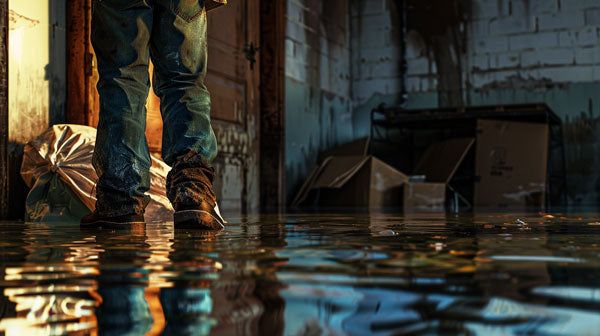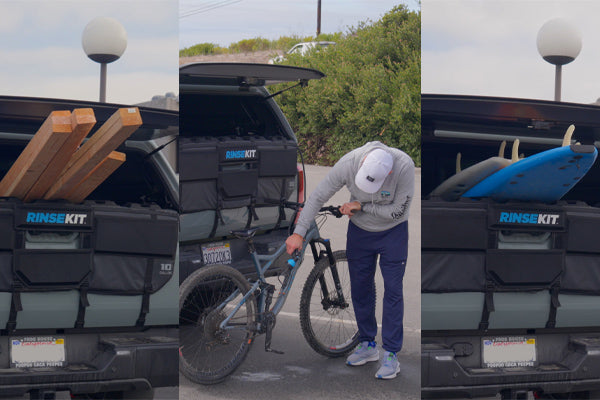
Basement flooding isn’t just inconvenient—it’s a full-on crisis. Whether it’s from a heavy storm, a burst pipe, or a sump pump failure, the damage can be extensive and expensive. The moment you spot water creeping across your basement floor, you know the clock is ticking. Every hour counts. The longer it sits, the worse it gets: mold begins to spread, structural damage sets in, and what was once a usable, comfortable space starts to feel more like a swamp.
But as overwhelming as basement flood clean up can be, having the right tools makes all the difference. With the proper gear in hand, you can move quickly, minimize damage, and prevent long-term issues. From water removal to sanitization, each tool serves a purpose—and one of the most underrated yet vital tools in this lineup is a portable water spraying system, like RinseKit.
Below, we’ll walk through the top 10 essential tools for cleaning up a flooded basement—and explain why RinseKit is a total game-changer for this kind of situation.
1. Protective Gear
Before you start hauling out wet boxes or vacuuming up water, protect yourself. Floodwater often contains contaminants like sewage, gasoline, pesticides, and bacteria. You’ll need:
-
Waterproof boots with non-slip soles
-
Thick rubber gloves
-
Safety goggles
-
N95 respirator mask (especially if mold has started to grow)
This gear isn’t overkill—it’s essential. Safety comes first, and floodwater is no joke.
2. Heavy-Duty Trash Bags
Once the basement’s been exposed to floodwater, anything porous (like cardboard boxes, insulation, fabric furniture) likely has to go. That means trash bags. But not just any kind—look for contractor-grade, tear-resistant bags that can handle heavy, waterlogged items without splitting open on the way to the curb.
3. Wet/Dry Vacuum
The first major task in basement flood clean up is removing standing water. A high-capacity wet/dry vacuum is critical for this job. Unlike traditional vacuums, these are built to suck up water and solid debris alike. You’ll want one with a wide hose, good suction power, and a drainage port to make emptying it faster.
4. Squeegees and Mops
Once the water’s mostly gone, you’re still left with puddles and slick surfaces. That’s where a good floor squeegee and an absorbent mop come in. Squeegees help push water toward your floor drain or into a wet vac, while mops can pick up the remaining moisture. Microfiber or sponge mops work especially well for concrete and tile floors.
5. Disinfectant and Cleaning Supplies
Cleaning up floodwater isn’t just about removing the mess—it’s about making sure your basement is sanitary again. Disinfecting is essential to kill any lingering bacteria or mold spores. Stock up on:
-
Industrial-grade disinfectants (bleach-based or EPA-registered cleaners)
-
Stiff scrub brushes
-
Microfiber cloths
-
Buckets for rinsing
This is where you'll start to notice that using a portable sprayer like RinseKit can make this step a whole lot easier and more efficient (more on that soon).
6. Dehumidifiers and High-Powered Fans
Moisture is the real enemy post-flood. Even if your basement looks dry, high humidity can cause mold to develop behind walls and under floors. Use industrial fans to circulate air and a powerful dehumidifier to pull moisture from the air. Let them run for several days—yes, days—until your moisture levels stabilize.
7. Shovels and Buckets
In floods that bring in mud, soil, or silt, you’ll need a sturdy shovel and multiple buckets. You’ll be surprised how much sediment water can carry into a space. Flat-edged shovels are ideal for scooping from hard surfaces, while wide buckets make for quick and easy transport.
8. Moisture Meter
This tool helps you confirm when walls, floors, and materials are truly dry. Moisture can linger inside drywall and wood long after surfaces appear dry to the touch. A pin-type or pinless moisture meter gives you accurate readings so you know whether it’s safe to begin repairs or if you still need more drying time.
9. Portable Generator
Floods often cause power outages, especially if the electrical system was affected. A portable generator keeps your cleanup tools—vacuums, fans, dehumidifiers, lights—running even when the grid is down. Look for models with enough wattage to power multiple devices at once.
10. Portable Water Spraying Solution (Like RinseKit)
Most people don’t think of this one immediately—but once you use it, you’ll wonder how you managed flood cleanup without it.
Why a Portable Water Sprayer is a Secret Weapon for Flood Cleanup
Once the water is gone and you’re deep into the cleaning phase, you’ll need clean, pressurized water to rinse off mud, wash down walls, clean your tools, or even hose off your boots before going back upstairs. But here’s the catch: your plumbing might be compromised or shut off. You may not have easy access to a hose spigot near the basement. That’s where RinseKit steps in—and excels.
Meet RinseKit: Your Basement Flood Cleanup MVP
RinseKit is a self-contained, pressurized water system that doesn’t require electricity or a hose to function. You fill it up in advance (or from a clean water source), and its battery-powered pressure system empowers you to spray water exactly when—and where—you need it.
What Is RinseKit and How Does It Work?
RinseKit is a portable, battery-powered water spraying system designed to deliver strong, consistent water pressure wherever and whenever you need it—without requiring a hose, faucet, or external power source. Unlike traditional sprayers that rely on manual pumps or gravity, all RinseKit models now feature built-in rechargeable batteries that power the pressurization system, giving you powerful spray performance at the push of a button. With tank capacities ranging from 3.5 to 10 gallons, RinseKit offers ample water for tough cleaning tasks, whether you’re rinsing down muddy floors, washing off tools, or blasting debris from hard-to-reach corners. Simply fill the tank with clean water, turn it on, and you’re ready to go—no plumbing or complicated setup required. For basement flood cleanup, this kind of reliable, portable water access is a game-changer, letting you clean efficiently in spaces where water lines may be shut off or inaccessible.

Key Features That Make RinseKit Ideal for Basement Cleanup:
-
Pressurized Water Without a Hose
RinseKit uses battery-powered pressure to provide a consistent spray at 50 PSI. No garden hose. No outdoor faucet. Just pressurized water where you need it. -
Portability in Tight Spaces
Basements are often cramped or filled with debris post-flood. RinseKit’s compact size and grab-and-go handle make it easy to maneuver into corners, tight stairwells, or behind furniture. -
Rinse Mud, Mold, and Contaminants from Surfaces
Before you disinfect, you need to rinse. Use RinseKit to wash off muddy concrete floors, drywall, or tools. It helps remove the first layer of grime so your disinfectants can do their job more effectively. -
Spray Off Dirty Tools and Boots Outside
Keep the rest of your house clean by using RinseKit outside or in a garage to spray down wet boots, gloves, and equipment. No dragging mud through your home. -
Heated Water for Better Cleaning
With the RinseKit HyperHeater accessory, you can heat water to sanitize contaminated areas more effectively. This is especially useful when dealing with bacteria-heavy floodwater or attempting to clean areas with visible mold. -
No Power? No Problem
Many RinseKit models don’t need electricity to function. Even if the grid is down, you’ll still have pressurized water at your fingertips. Battery-powered versions offer even more flexibility and duration. -
Refillable Anywhere
Fill your RinseKit at a clean water source, use it, and refill as needed. It’s fast, easy, and doesn’t require plumbing access—perfect in an emergency situation.

Real-Life Uses During Basement Flood Recovery
Still wondering how RinseKit actually fits in the flood cleanup process? Here are just a few of the practical ways it shines:
-
Pre-rinse surfaces before applying disinfectants
-
Blast mud and gunk out of corners or grout lines
-
Clean HVAC grates and vents affected by floodwater
-
Spray down sump pumps or drainage equipment
-
Rinse soap or disinfectant residue off floors or walls
-
Clean personal protective gear between session
A Cleaner Basement Starts with the Right Tools
Dealing with a flooded basement is stressful, dirty, and time-consuming. But the right gear makes it manageable—and even efficient. From heavy-duty vacuums to moisture meters, each item in your toolkit plays a critical role in restoring your space. But don’t overlook the value of a portable, pressurized water sprayer like RinseKit. It offers flexibility, mobility, and power when you need it most.
In emergency situations, RinseKit helps you work smarter—not harder. It provides exactly what you need to get your basement clean, dry, and livable again: accessible, pressurized water, no matter where you are or what your plumbing looks like.
If basement floods are a possibility where you live—or if you’ve already faced one—consider making RinseKit part of your flood cleanup plan. It could be the most versatile tool you didn’t know you needed.



